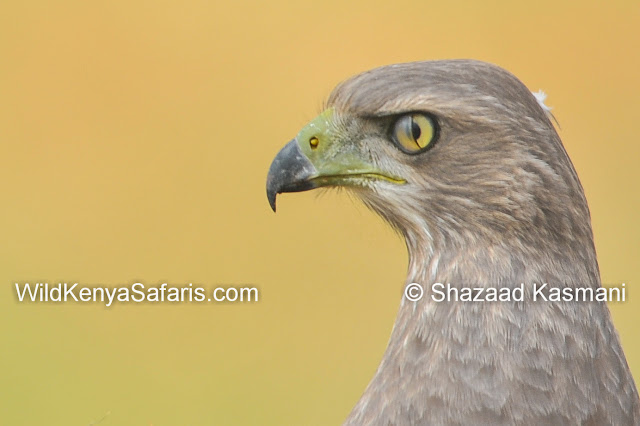 |
| An Immature Pale Chanting Goshawk 'Melierax Canorus' searches attentively for some prey in Tsavo East National Park |
The greatest weapon that a predatory bird possesses is not the length of its talons, nor is it its body size, nor the speed with which it can fly. Its most vital hunting tool is actually the good health and sharpness of its eyes!
For a bird of prey such as the above pictured Goshawk to successfully survive in the wilderness, it needs to be able to identify the smallest of potential prey hiding on the ground (like mice and lizards) at a close-up range even though the bird is searching from high up in the sky. The moment its large eyes spot a potential target, it needs to accurately judge the distance, direction and momentum of its prey, then as it dives in for the kill, it literally needs to keep its eyes on the prize by continually having its target in clear sharp focus during the high speed aerial chase. Birds of prey unquestionably have some really complex and superior visual capabilities compared to those of human beings!
 |
| A Goshawk in Tsavo East Kenya with its eye clearly visible |
So with eyesight being an extremely critical tool to the raptors hunting success, its no wonder that they actually have three eyelids; The Lower Eyelid, The Upper Eyelid and The Nictitating Membrane. It's thanks to the functionality of all three eyelids that the raptor is able to continually keep its eyes clean and hence increase its odds for a successful hunt.
The Upper and Lower eyelids open and close with an up and down movement, these help to keep the dust and grit away by simply blinking. The blinking technique is normally used when the bird is perched up on a branch or when its walking on dusty ground. The Nictitating Membrane however, is the principal eye cleaner. This third eyelid is a semi transparent membrane that can slide horizontally across the eye, so it works much like a windshield wiper would when cleaning the glass of the car. As this membrane moves across the eye from left to right, it automatically cleans and lubricates the eyes in the process.
 |
| The Nictitating Membrane as seen above slides across the Goshawk's eye keeping it clean and moist |
Because this membrane is semi transparent in nature, the raptor is also able to retain some sort of vision. This is helpful because it can continually remain watchful on everything that's happening in the environment around it.
Here is something for you to try, every time you blink your eyes ....go on and blink them! .... notice that you loose complete vision for about 1/3 of a second.
Now when a raptor is flying at high speeds during an aerial chase, the fast moving air that's hitting its face contains a lot of dust particles that would naturally irritate its vision, and the strong wind would also start to dry up the birds eyes. This is where the Nictitating Membrane really comes into play, it helps to clean, moisten and protect the eyes in one single swipe and the raptor would not loose visual contact of its prey or the fast approaching ground. If the raptor would choose to blink rather than swipe to clean its eyes at this time, it would most likely loose sight of its prey, miscalculate the correct distance or possibly even hit an obstacle like a branch.
So the next time you see a bird of prey soaring high up in the skies, you now know how it is able to keep its eyes clean during the flight.
So the next time you see a bird of prey soaring high up in the skies, you now know how it is able to keep its eyes clean during the flight.
Comments
Post a Comment